Concrete and Walnut Dressing Bench
Ok here we got with another build. These builds are my favorite part of running this site, but unfortunately they are also the most time consuming to create. Believe me I wish I could be pumping them out at a faster rate, but I’m only one man (and a lazy one at that).
You know the drill though. I’ll start with the finished photos and then we’ll get into how I made it.
This dressing bench is made from walnut and concrete. It’s my first time working with concrete in a furniture build and I love how it turned out.
Before we get into the rest of the post if you havent already, check me out on Instagram! You can find me @zacbuilds or (direct link: https://www.instagram.com/zacbuilds/)

I really wanted to add a dressing bench to my place. A nice place to put on your shoes or socks and get ready for the day. No more sitting on the edge of the bed for me.

This bench is made from a single piece of walnut. As you move along it the pattern of the grain is never lost. It creates the illusion that someone folded a 2″ thick slab of walnut at a 90 degree angle. It’s a cool look that is sometimes called a water fall edge.

A bench with one waterfall edge is cool, but two is just excessive. Plus, you know, a u-shaped bench is a bit of a snoozefest. To make things more interesting I brought in another material and went for an asymmetrical design.
One of my readers suggested I do a project involving concrete so I decided I would make the second leg out of poured concrete.
Nothing fancy about this concrete, this is the 5 dollar stuff you get in a 60lbs bags at the hardware store. As far as building materials go it might just be the cheapest thing you can buy by the pound.

Here’s a rough design I did in Sketchup to figure out dimensions and measurements.
I actually designed the bench to go in my bedroom at the foot of my bed, but my bedroom is currently in a state of renovation and didn’t look very good for the finished photos. That’s why all the photos you’ve seen so far have been in my living room.
If anyone is interested in the Sketchup file, just let me know and I can send it to you or make it available for download.

Here’s what I started this project with. A single piece of 2″ x 11.5″ walnut that’s 6′ long. 1 Bag of concrete mix I had left over from a job and some scrap melamine sheets. Melamine is the stuff that you make the inside of cabinets with.
The only thing that I had to pay for was the Walnut, which ended up costing me an eye watering $120 CAD. Is it just me or is wood WAY too expensive these days?! Like seriously, 120 bucks for 1 piece of wood?
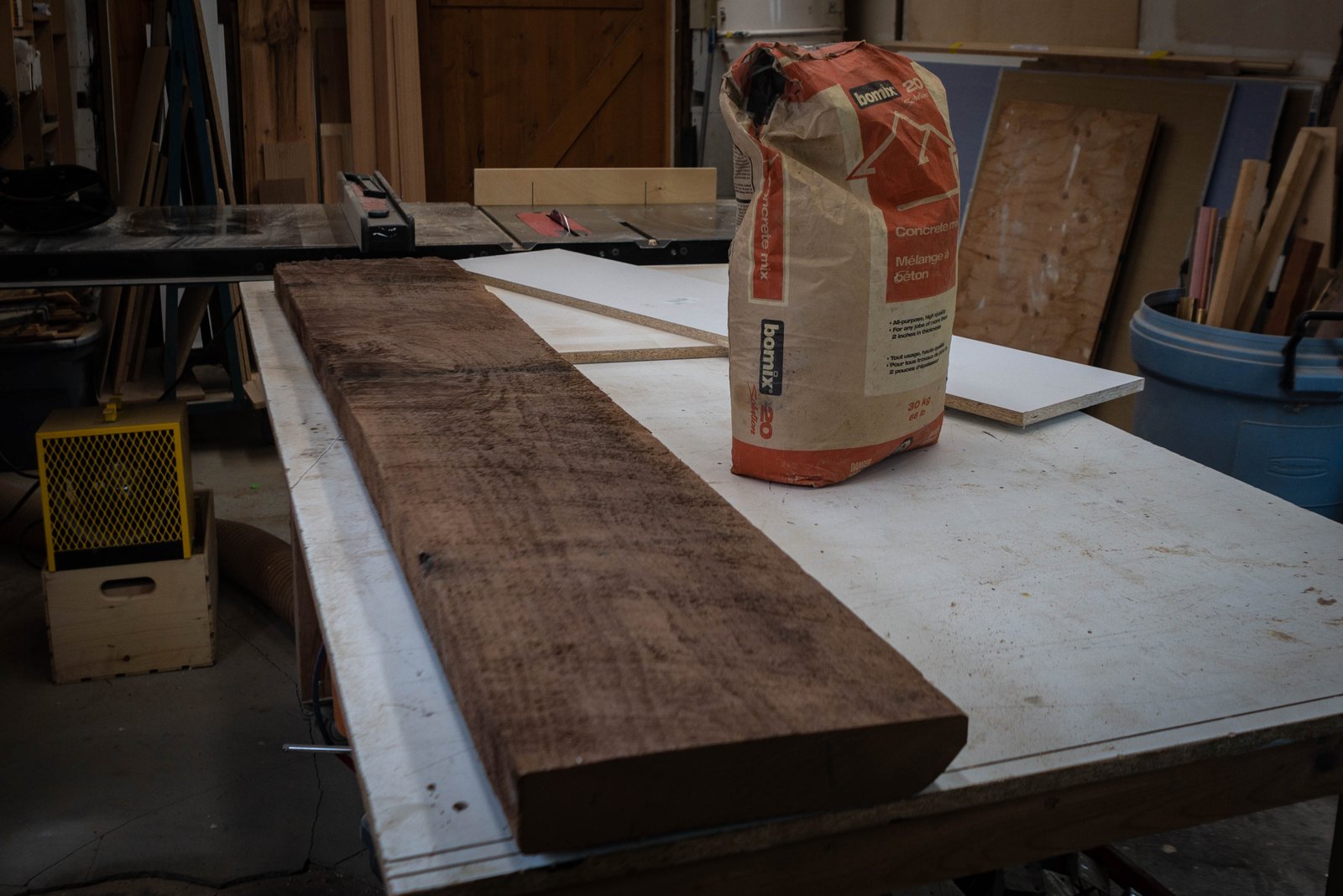
The concrete was going to take a long time to dry so I decided I would do that first.
In order to form the concrete leg I was going to need a mold. That’s what the scrap melamine was for. I used melamine instead of ply wood because it has a perfectly smooth surface that wouldn’t stick to the concrete once it was dry.
I ripped 2 pieces that were 1.5″ wide and 32″ long on the table saw.

Then I took those pieces and further cut them down so I had 2 piece that were 18.5″ long and 2 piece that were 9″ long.

The next piece of melamine I cut was 18.5″ x 10.5″, this piece is the bottom side of my mold.

Using #8 1.5″ wood screw, I screwed it all together.
I pre-drilled and counter sunk all of my screws just to be sure I didn’t split the melamine board. I was also careful to make sure all of my edges sat flush and square. Any imperfections in the mold would end up being imperfections in the finish product, and imperfections in my builds are NOT tolerated 🙂
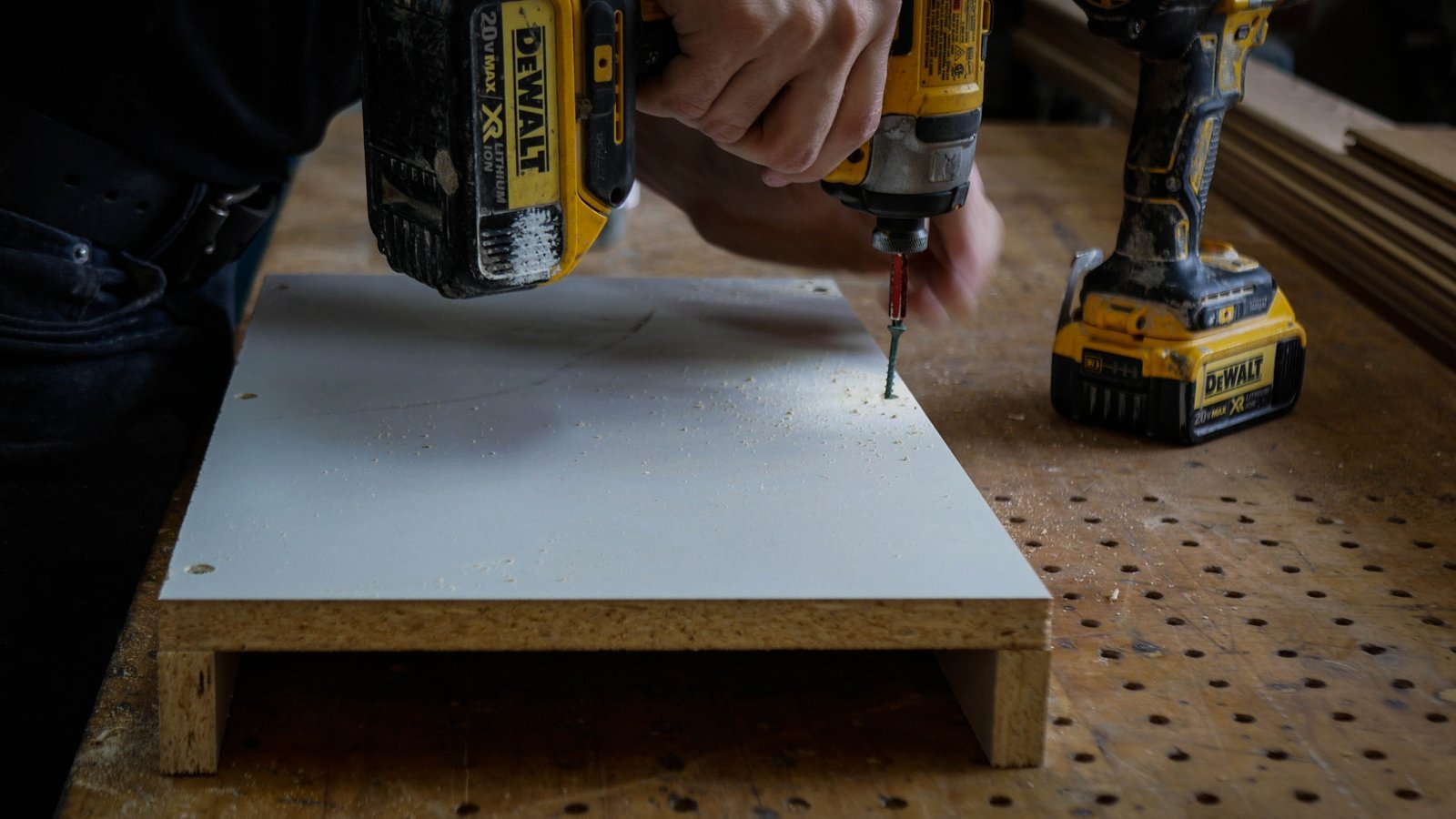
I forgot to show these in the first picture but I cut a couple of 3/8″ diameter pieces of steel rebar to 7″ long.
Not only will they reinforce my concrete but I got this sweet picture of a bunch of sparks to add to my instagram! At the end of the day I do it all for the ‘gram.

Concrete, while incredibly strong in some ways, is very weak in other ways. If I were to drop the leg without the rebar it would probably smash into a million pieces.
By adding these pieces of steel to the core of my concrete leg I’ll make sure it’s good and strong.
This is basically the same technique that is used to keep concrete building and bridges from cracking and falling apart too!
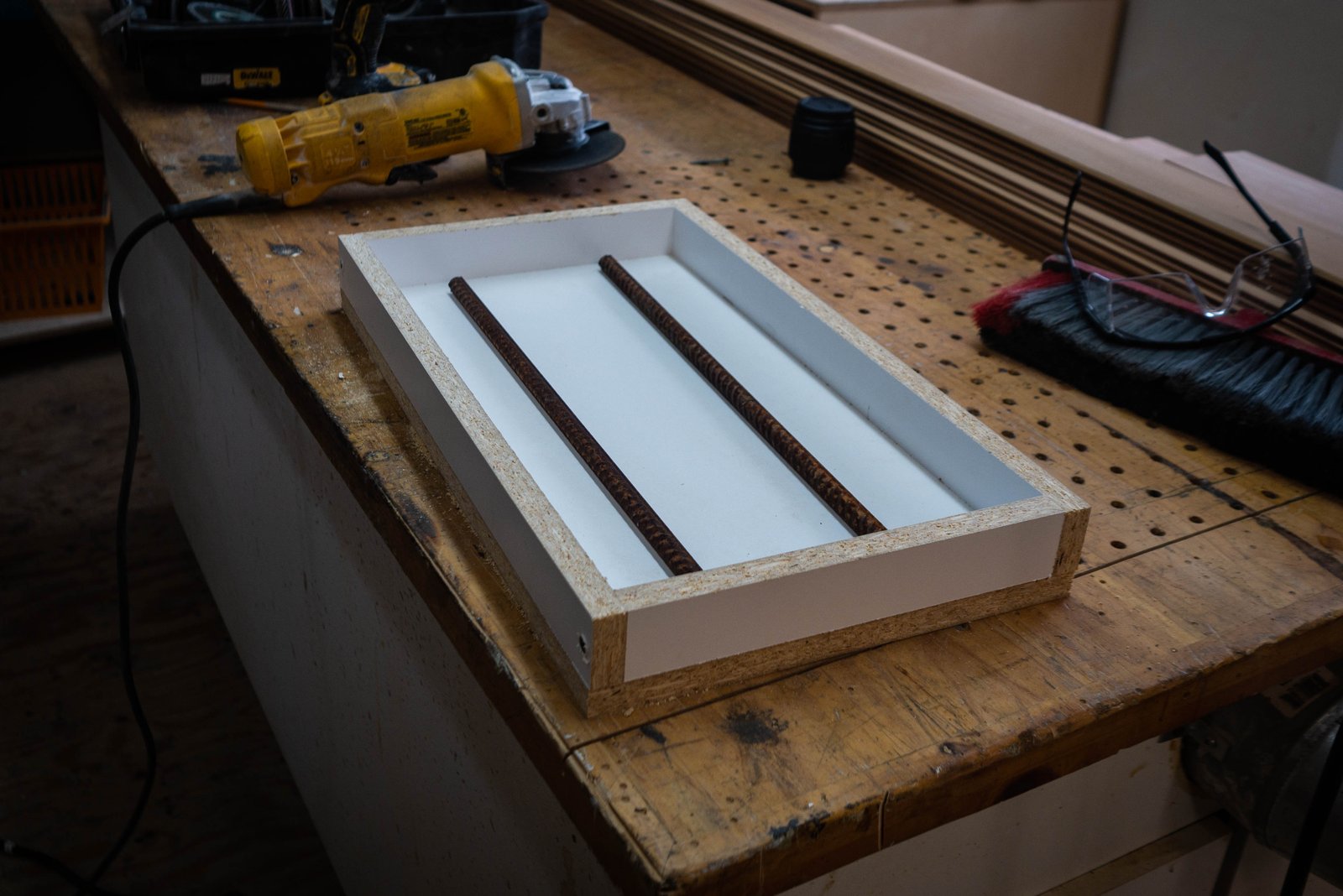
Ok time to get DUSTY. Concrete dust is incredibly fine and loves to hang in the air for a long time. You’re going to want to wear a dust mask for this part, even if you’re working outside.
I poured my concrete into a wheel barrel and got to work on mixing it up.

After adding some water and mixing my concrete this is what the finished consistency looked like.
Err on the side of it being a bit too dry if you’re following a long at home.
You can always add more water, but it’s impossible to take it out. For reference that is about half a bag mixed up and was only a little bit more than I needed. You’ll need more than you might think.
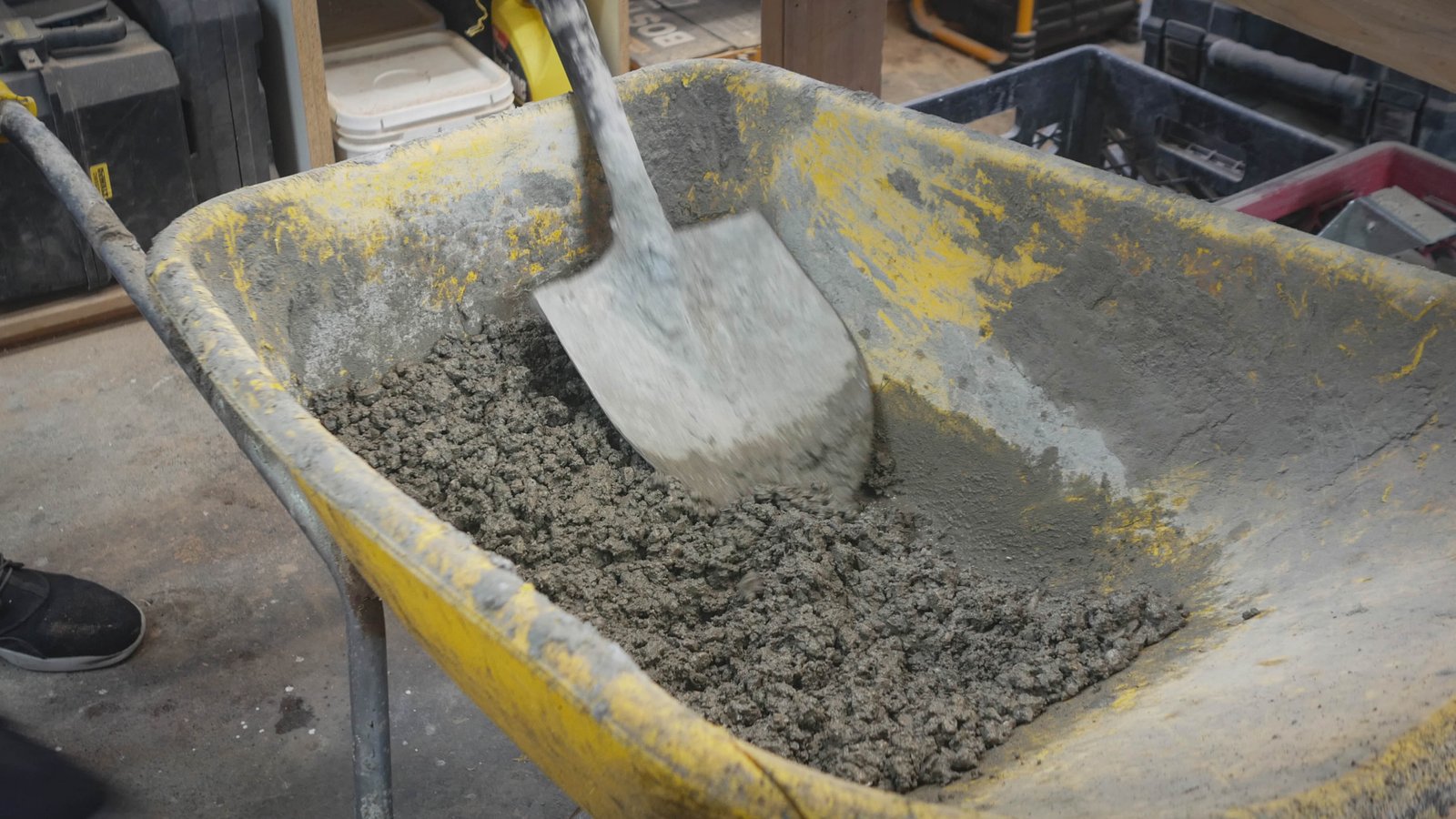
I filled the mold halfway up with concrete and packed it in tightly. Then I grabbed my 7″ piece of rebar and pushed them into the concrete. It helps if you wiggle them ever so gently as you push them down and into the concrete.

I filled the rest of the mold with concrete and smoothed it over with a large flat trowel.
Depending on the look you are going for you may want to spend some time agitating your concrete to try and work out any air bubbles trapped in the concrete. I repeatedly raised and then dropped the mold from a half inch above the table to help vibrate out any air bubbles.
After air bubbles stopped surfacing I worked the top with a trowel for a couple of minutes. Pressing down with the trowel and sliding it back and forth to remove any excess concrete from the mold.

Time to take the concrete out to dry in the sun!

Fast forward 24 hours later and the concrete was dry enough that I could undo the mold and check out my finished leg.
It has this awesome potmarked texture. I really like how it turned out. As the concrete continues to cure it will dry to a lighter shade of grey.
At this point the concrete is actually still quite weak so I was very careful handling it. After removing the mold I took it outside and put it back in the sun to continue to cure. I waited 72 hours before I brought it inside and even then it still wasn’t fully cured.

Ok enough concrete. I write a wood working blog, I should probably have some wood working somewhere in this post.
I fed my piece of walnut through my planer in order to smooth the surface and remove any irregularities in its surface. This took about 15 passes, each pass removes only a thin layer of wood. It’s a bit time consuming but it makes for a very nice, very flat finish.

I was left with a piece of a wood that while quite flat, had a slight curve to it. Can you see it in the picture? That’s no trick of the camera, the piece of wood is subtly shaped like a C.

I setup my tracksaw track and took another picture so you could see what I’m talking about. The track is perfectly straight. At the point closest to the camera it’s about 1/4″ away from the edge of the wood. Same thing at the end closest to myself. In the middle of the piece the edge of the tracksaw track and the edge of the wood line up perfectly.
If you’re unfamiliar with what a tracksaw is, it’s just a circular saw that fits into a track and gives you a perfectly straight and repeatable cuts. It’s a great tool I highly recommend to anyone who enjoys woodworking.
Cutting through 2 inches of solid walnut is no joke though, so I had to make this cut in multiple passes. Each pass I set the depth of my track saw half an inch deeper. If I didn’t I might have burned out the motor in the saw.
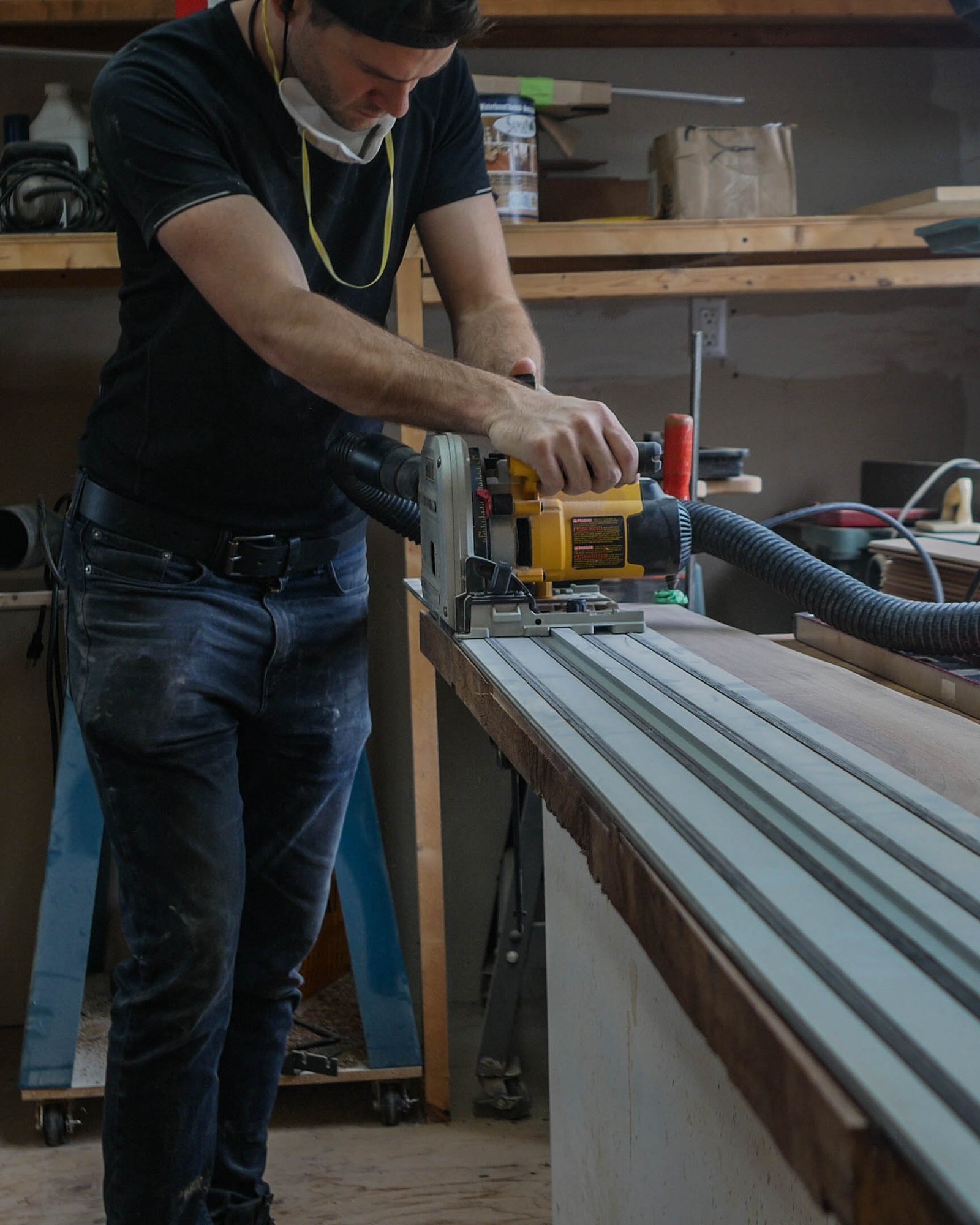
After I knew one side of the board was perfectly straight I used my table saw to make sure the other side was perfectly straight as well. I set the width on my table saw to 11″ and pushed the piece of walnut through the blade.
Why not use the tracksaw for this cut as well? Well, I could have, but truth be told the table saw is faster and more convenient. No need to make a cut in multiple passes when you’re working with a big powerful table saw. Its large motor is more than powerful enough to cut right through 2 inches of solid walnut in a single pass.

Now that I had a long straight piece of walnut I needed to create that waterfall edge. I had to “fold” the wood in on itself.
To accomplish this I needed my handy sliding miter saw. I measured 18″ from the end of the board and made a single 45 degree cut across the width of the board.

Then I rotated the blade 90 degrees so that it was cutting a 45 degree angle in the opposite direction.
I had to make both of these cuts slowly and carefully, any mistakes would ruin my waterfall look.

I laid out both the remaining piece of walnut so you could see what I removed from the board to create the fold.
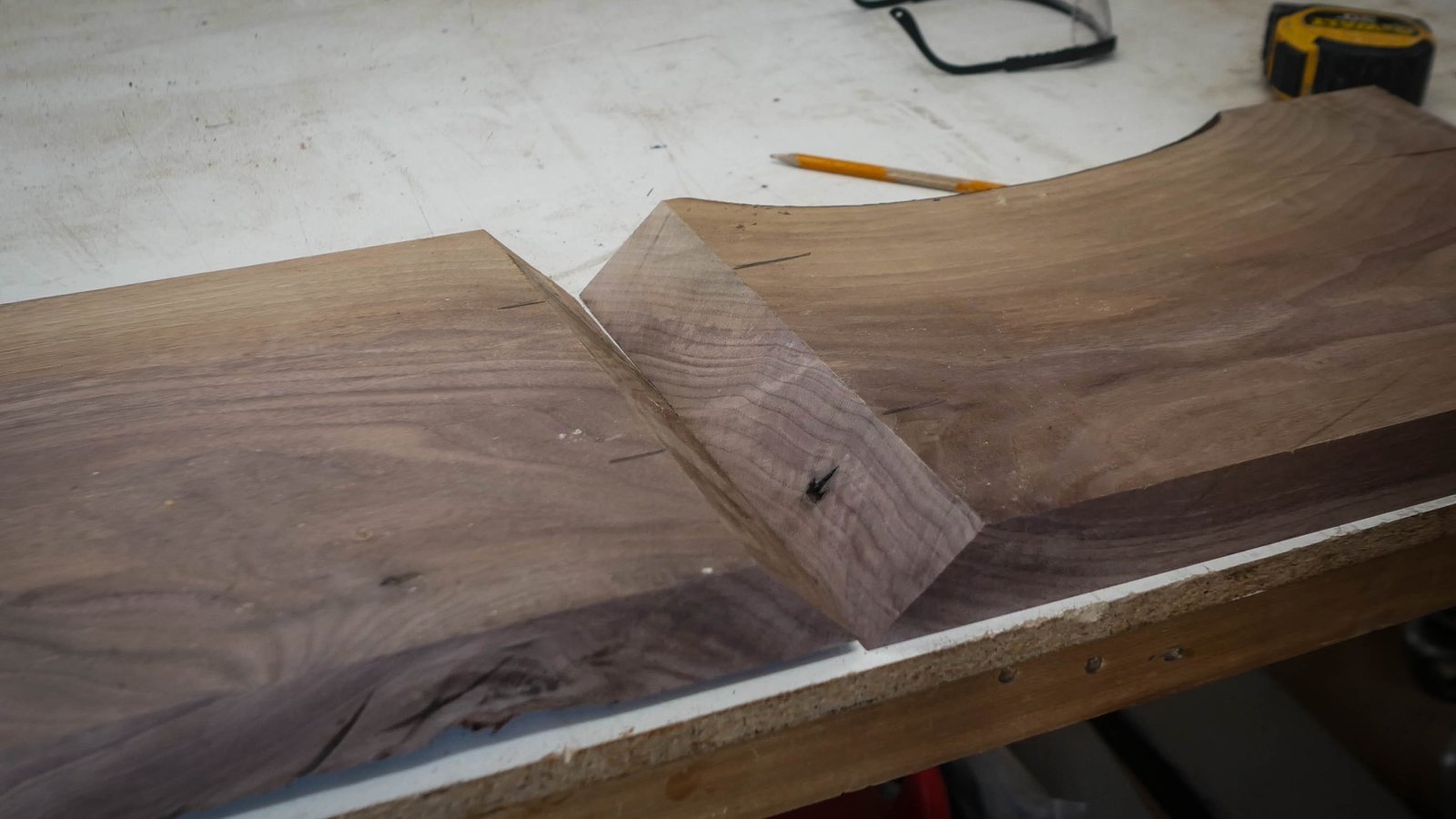
Ok so now I have 2 piece of walnut, but I dont want 2 separate pieces of walnut. That wouldn’t make for a very enjoyable benching experience. I had to join the wood back together, and for that I used a biscuit jointer. A biscuit jointer makes pocket grooves in wood so that you can slot in wooden “biscuits”.
I made 8 biscuit pockets, 4 on each piece of walnut. Each pocket on the first piece had a corresponding pocket on the second piece of wood. The wooden biscuits served to bridge the gap between the pocket pairs.
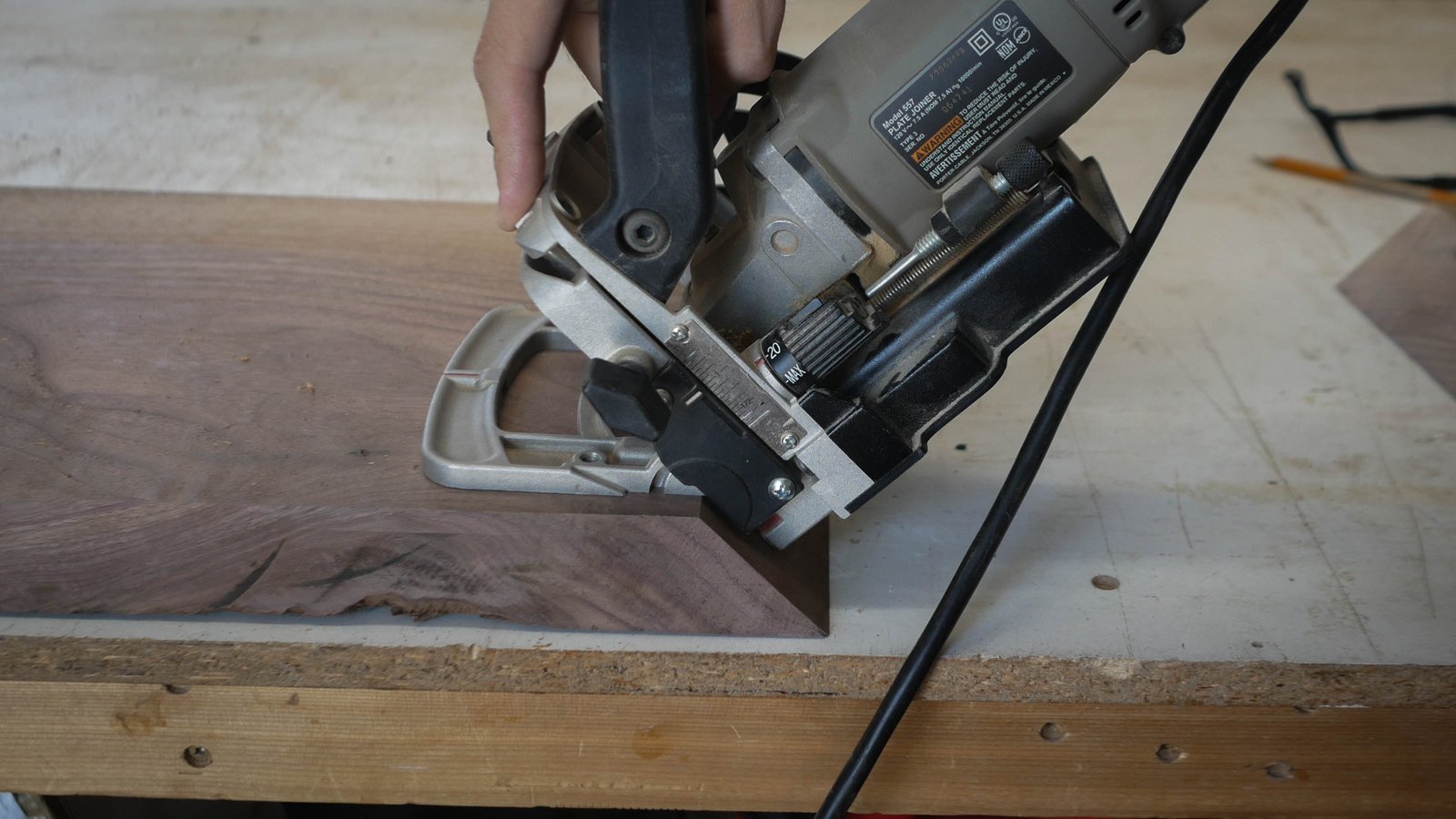
I inserted 4 biscuits into one of the pieces of wood and slathered the whole thing with carpenters glue. I spared no glue as you can see here. *insert Jackson Pollock joke here*

Thankfully I measured my biscuit joints correctly and everything lined up. After that it was just a matter of carefully aligning my two pieces of walnut so that they sat as flush with each other as possible.

Ever wanted to see what my face looks like when I’m turning a very small handle as hard as I can? Well nows your chance!
In order to prevent anything from moving while the glue was drying I used long bar clamps to clamp everything in place. I really wish I had some 90 degree clamp to use here, but I don’t. My system worked, it’s just a bit of a pain to setup.
At this point I left for the night to give the glue a chance to dry.

Ok so now we are entering day 2 of the build. I removed all of the clamps on the bench and after checking to make sure my two piece of walnut had been merged back into a single piece, I got to work creating a pocket for the concrete leg to slot into.
I didn’t want to use a mechanical connections to hold the concrete leg to the bench. The walnut by itself already weighed close to 40lbs. If I permanently attached another 30lbs of concrete to this bench I don’t think I would’ve been able to move it around. Instead I wanted to create a pocket that the concrete leg would slide into and then friction and gravity would hold the bench together. That way if I need to move it in the future I can do it in pieces.
Using a digital angle gauge (I love that thing) I traced 2 parallel 15 degree line onto the bottom of the bench. I used those 2 lines to form the basic outline of the pocket I would slot my concrete leg into.

Once my outline had been sketched I grabbed my plunge router off the shelf and got to work carving out my pocket. I setup the router with a 1/4″ cutting bit and started slowly removing wood. When I was done I had a pocket that was 1.5″ x 9″ and 1″ deep. Like the track saw I had to do this in many small passes to avoid burning out the routers motor.

After I had the pocket cut, I grabbed the concrete leg to test fit it. Hurray! It fit on the first try!
Because there is no mechanical connection holding the concrete leg in place, just friction and gravity, I had to make this tight pretty tight to avoid any movement in the finish product. I’m happy to say the finished product is strong and sturdy.

As always when working with unfinished lumber there were some small cracks and imperfections. To correct these I grabbed some walnut colored wood filler and smushed it into any gap I could find.

Finishing time! I gave the whole thing a really good sanding with my random orbital sander. I started with 80 grit sand paper to remove big imperfections and shape the edges of the bench. I rolled the sander from the vertical surface to the horizontal surface to help shape the water fall edge as well.
Then I moved onto 120 grit sand paper and finally to 220 grit sand paper. By the time I was done sanding it was smooth as a babies bottom. (Note to self: Find an expression for smoothness that sounds less “pedo-y”)

To protect and seal my bench I wanted to apply a clear coat to it. I used this Hybrid Oil Floor Varnish with a satin finish. I use this stuff on almost all of my projects. It gives a nice sheen that isn’t too glossy and it dries really quickly which makes doing multiple coats a breeze.
This stuff is also very forgiving of mistakes (though not as forgiving as their water based version). Small imperfection like brush strokes and small bubbles disappear as it dries.

I grabbed my mini roller and rolled it onto the flat parts. To reach the corners I used a 2″ paint brush.
I got a little lazy here and used a foam roller (it’s all I had on hand), but really, a low nap regular roller would’ve been ideal. The foam rollers can leave little bubbles which need to be sanded out between coats. If you miss one it can get trapped under layers varnish and become permanent, so I had to be careful to avoid that.
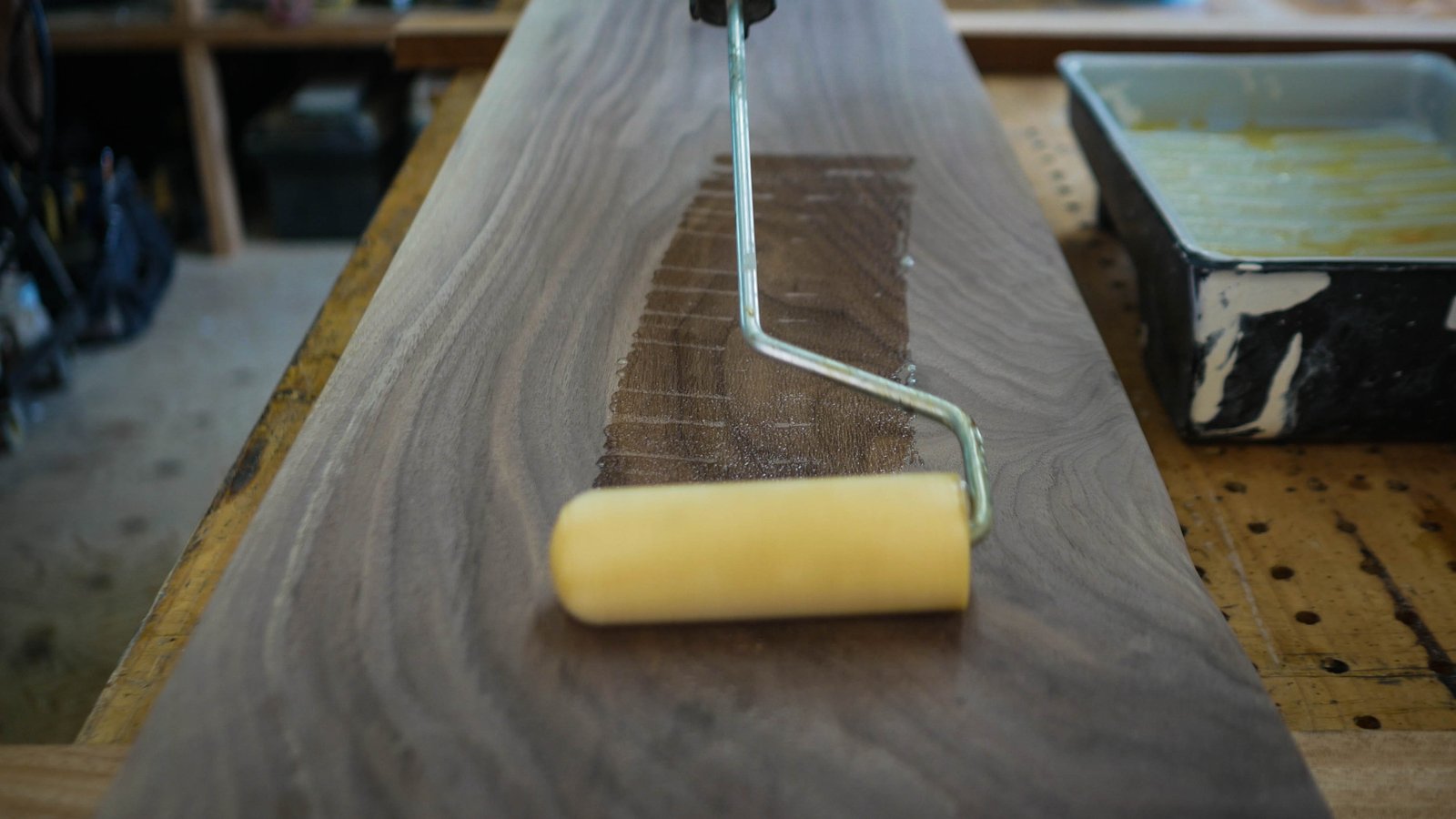
Between each coat I sanded the whole thing with 300 grit sand paper on a sanding block. I really wanted this thing to a have a perfect finish so I pulled out all the stops and took my time.
In the end I ended up giving this bad boy 4 coats of varnish. All those coats make it super durable and seal that wood up real tight.
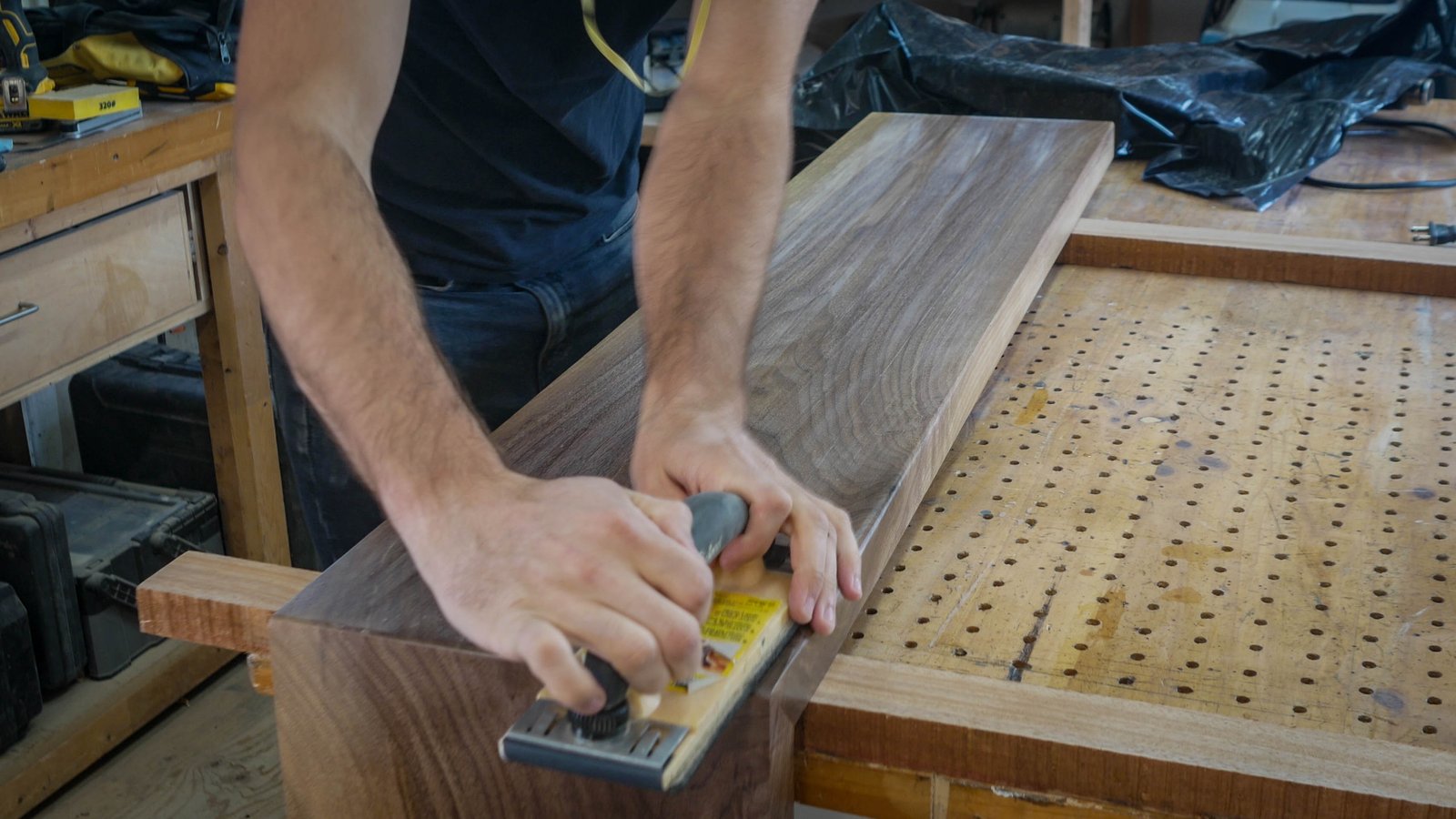
I’m a walnut fan boy. C’mon, you can’t beat grain that looks like that! And those deep, purple-y browns are just too nice!
A lot of my furniture is made out of Walnut so this bench really ties into the rest of the space nicely.

Here’s how it looks in my living room. This will be its temporary home until my bedroom is fully setup and ready for it. Although I kind of like it here, so maybe this will end up being its permanent home, hmmm….
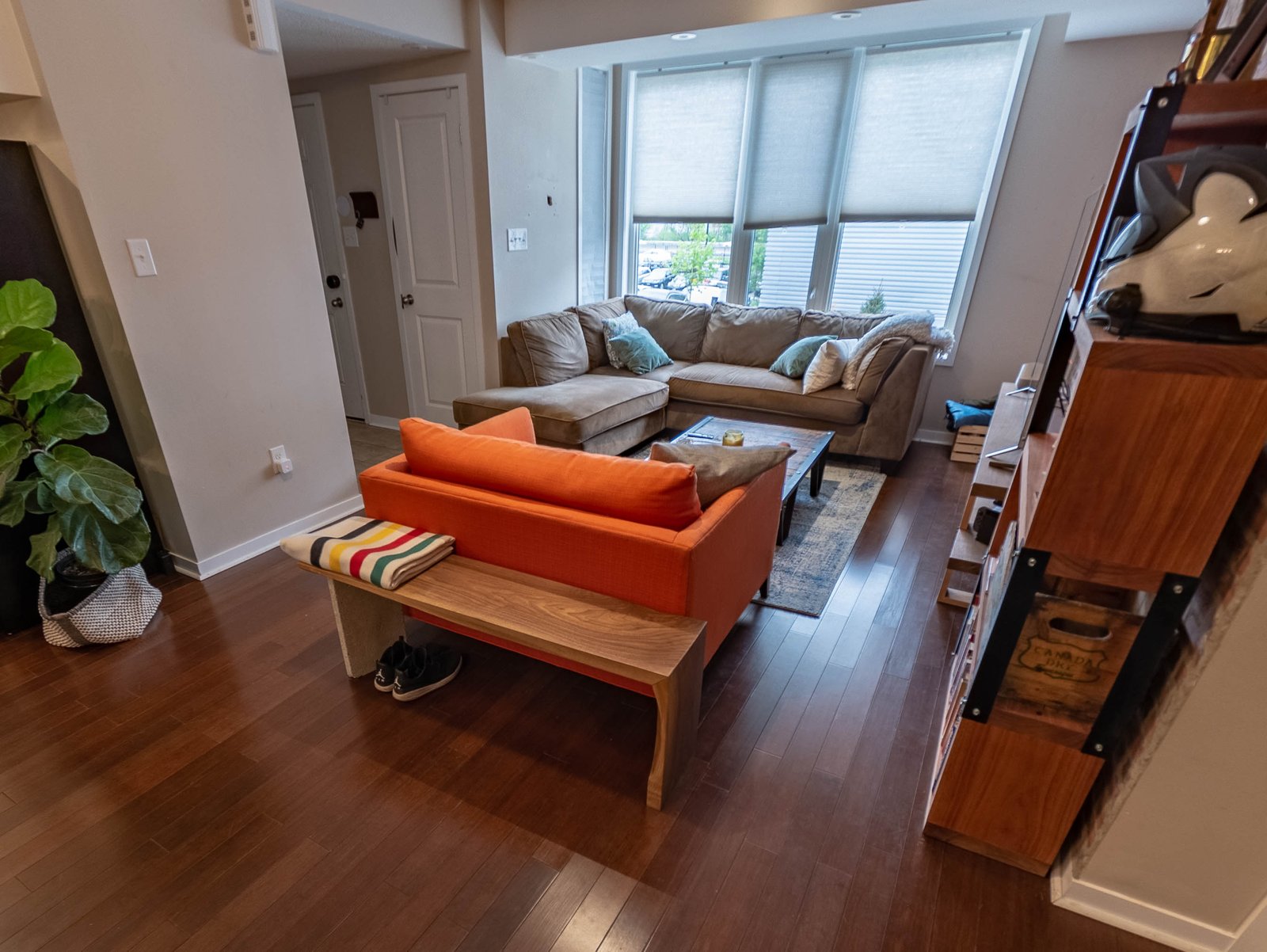
I originally thought about doing this bench with a live edge piece of walnut, but the problem is that live edge wood doesn’t usually lend itself to have waterfall edges. Due to its irregular sides it can look weird when you “fold” it.
So instead I tried to grab piece of walnut with a little bit of character. This piece was missing a big chunk out of the side of it and has another similar chunk missing out of the other side. I like them, they add a bit of character to a project that has a lot of straight lines.

Here’s a closeup of the concrete leg. I really love how the texture of it turned out. I suspect if I had mixed the concrete with more water it may have resulted in fewer bubbles, but I really like this look.
Some people may be asking themselves why I chose to angle the concrete leg, and the reason is pretty simple, it’s because I wanted to show off the concrete leg. Turning it out towards the front of the bench makes it more visible.

See how the lines of the grain line up? That’s what I was rambling about earlier.

Thanks for checking out my build! Let me know if you have any questions about how I did anything in the comments, I’m always happy to help!